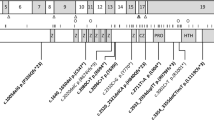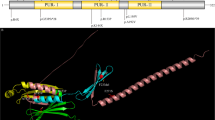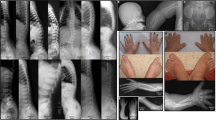Abstract
We report on a 15-year-old Japanese female patient with hypotonia and global developmental delay from the neonatal period who was revealed to carry a known pathogenic PURA variant (NM_005859.5:c.697_699del, p.Phe233del) by whole-exome sequencing. She had previously unreported clinical features, including a rectovestibular fistula, extremely short stature, and underweight, expanding the known phenotype of PURA syndrome.
Similar content being viewed by others
Purine-rich element-binding protein A (PURA) syndrome (MIM #600473) is a rare genetic disorder characterized by moderate-to-severe intellectual disability with hypotonia, hypothermia, hypersomnolence, feeding difficulties, excessive hiccups, recurrent central and obstructive apnea, epileptic seizures, abnormal nonepileptic movements, and abnormal vision1. Purine-rich element-binding protein (Pur) is a sequence-specific, single-stranded, nucleic acid-binding protein that is highly conserved from bacteria to humans2. Purα is a Pur member involved in neuronal proliferation, dendrite maturation, and the transport of mRNA to translation sites in hippocampal neurons; it also has an important role in postnatal brain development3,4.
According to the PURA Syndrome Foundation (https://www.purasyndrome.org/family), over 478 diagnosed cases have been reported worldwide as of September 2021. However, because the disease is not widely known among clinicians, it is conceivable that many patients have yet not been diagnosed. Here, we report a Japanese female patient with hypotonia and global developmental delay carrying a known pathogenic PURA variant (NM_005859.5:c.697_699del, p.Phe233del). This patient had clinical features previously unreported in association with PURA syndrome, including underweight, an extremely short stature, and a rectovestibular fistula5,6,7,8,9.
The 15-year-old patient was first referred to our hospital at the age of 5 years. She is the third daughter of nonconsanguineous healthy parents, with a healthy older brother and sister. She was born at 37 weeks of gestation by vaginal delivery with a birth weight of 2740 g and Apgar scores of 7 and 7 at 1 and 5 min, respectively. She had labored breathing and hypotonia at birth and required oxygen therapy for several days. She also had poor sucking and weight gain and needed nasogastric tube feeding for 2 months. Brain computed tomography, magnetic resonance imaging (MRI), newborn screening tests for congenital metabolic diseases, and blood tests performed during hospitalization were all normal. Karyotype analysis showed a normal female karyotype of 46,XX. A chromosome 15 methylation test for Prader–Willi syndrome was normal, and there were no SMN1 gene mutations. She was discharged at 3 months of age with a weight of 4734 g. At the age of 1.5 years, she weighed 8.7 kg (–1.2 SD). She had severe allergies to eggs, milk, and wheat and experienced anaphylaxis several times. She also had severe constipation during infancy.
At the age of 5 years, she presented with marked hypotonia, a myopathic face, frontal bossing, a high-arched palate, esotropia, almond-shaped palpebral fissures, long, thin fingers, and soft skin (Fig. 1A). At the age of 7 years, she developed atonic, tonic, and gelastic seizures. An electroencephalogram (EEG) revealed occasional spikes, mainly over the left parietal region (Fig. 1B). She was diagnosed with epilepsy and was prescribed several anti-seizure medications. A nonepileptic exaggerated startle response to slight stimulation involving splaying of her arms was also often seen. Repeat brain MRI revealed no abnormalities.
A The patient at 13 years of age showing a myopathic face, frontal bossing, a high-arched palate, esotropia, and almond-shaped palpebral fissures. Written informed consent for the publication of photographs was obtained from the patient’s parents. B EEG of the patient performed at 8 years of age. C Growth chart of the patient showing height and weight. Growth curves are based on a cross-sectional growth chart for Japanese girls.
At the age of 10 years, feces was observed to pass from her vaginal vestibule. Physical examination revealed a slight fistula in her vaginal vestibule but no imperforate anus. An enema of gastrografin containing pyoctanin showed no fistula from her rectum to vaginal vestibule, but pyoctanin was attached to the vaginal vestibule after examination. Histological examination of the excrement from her vaginal vestibule showed the presence of food residue, so we diagnosed her with a rectovestibular fistula.
The patient has global developmental delay; she achieved head control at 6 years of age, sat alone at 7 years of age, and stood with support at 10 years of age. At 15 years of age, she cannot stand alone and needs full assistance when bathing and at mealtimes. Mobility is only possible in a wheelchair operated by another individual. She demonstrates social smiling and can use jargon but does not speak recognizable words. Growth was also significantly delayed; her height was 106 cm (–3.5 SD), her weight was 12 kg, her body mass index (BMI) was 10.7 at 8 years of age, and at 15 years of age, her height is 118 cm (–7.6 SD), her weight is 16 kg, and her BMI is 11.5 (Fig. 1C).
To confirm a molecular diagnosis, we analyzed DNA samples of the patient obtained at the age of 11 years and of both parents by whole-exome sequencing (WES) using the HiSeq 2500 System (Illumina, San Diego, CA). DNA samples were extracted from peripheral blood after receiving written informed consent from her parents. WES detected a heterozygous in-frame deletion (NM_005859.5:c.697_699del, p.Phe233del) in exon 1 of PURA in the patient but not her parents. This was confirmed by Sanger sequencing.
PURA p.(Phe233del) is the most commonly reported variation and was first identified by Hunt et al. in 2014; our patient is the ninth reported to carry the variant5,6,7,8,9. Table 1 compares all nine patients with the variant, revealing common clinical features including neonatal hypotonia, postnatal hypotonia, intellectual disability, language delay, and motor development delay. However, Patient 14, described by Reijnders et al., first sat alone at 1–2 years of age, while our patient achieved this at 7 years of age. Similarly, patient DB15-027, described by Lee et al., was able to walk alone at 4 years of age, while our patient remains unable to do so at 15 years of age. This suggests the presence of a wide range of developmental phenotypes among patients with the same PURA variant. Feeding difficulties, respiratory problems, hypersomnolence and hypothermia in the neonatal period, an exaggerated startle response, epilepsy, EEG abnormalities, brain MRI abnormalities, gastrointestinal abnormalities (e.g., constipation or drooling), vitamin D deficiency, and dermatological abnormalities (e.g., soft skin and cutis laxa) were observed in more than half of the nine patients. Our patient shared these clinical features, except for hypersomnolence and hypothermia in the neonatal period, brain MRI abnormalities, and vitamin D deficiency. The clinical features of patients carrying the PURA p.Phe233del variant do not differ from those reported for all patients with PURA syndrome, suggesting that it is difficult to describe reliable genotype–phenotype correlations5,9.
Our patient had a rectovestibular fistula, which has not previously been reported in patients with PURA syndrome. Congenital rectovestibular fistulas comprise the majority of anorectal malformations10. However, female anorectal malformations can be difficult to diagnose precisely because of anatomical complexities and the approximation of genital organs11. Acquired rectovestibular fistulas are often a symptom of a disorder such as Crohn’s disease, pelvic infection, and malignancy12. Our patient was diagnosed with a rectovestibular fistula at the age of 10 years when feces were observed to pass from her vaginal vestibule, but it was difficult to distinguish whether this was congenital or acquired by physical examination and imaging. Therefore, although it is unclear whether the fistula is associated with the PURA variant, our patient may expand the phenotypic spectrum associated with PURA syndrome.
Patients with PURA syndrome often have a short stature5,13. Indeed, Reijnders et al. reported that the height of 8/49 (16%) patients was ≤2.5 SD5. However, the extent of short stature and low weight of our patient, as shown in Fig. 1C, is incomparably stronger than in previous reports. Our patient lacks the limb shortening characteristic of achondroplasia, which is associated with a markedly short stature. Severely stunted height and weight growth can also result from inadequate caloric intake (such as that caused by difficulties with nursing or limited food availability), inadequate caloric absorption (such as that resulting from metabolic or gastrointestinal disorders), or excessive caloric expenditure/ineffective utilization (e.g., resulting from hyperthyroidism, diabetes, pulmonary, or cardiac conditions)14. Our patient could eat a certain amount of food with assistance, and physical examinations revealed no metabolic disorders, hyperthyroidism, diabetes, or cardiac disease. The possibility of inadequate caloric absorption from gastrointestinal disorders cannot be ruled out, but it should be noted that PURA syndrome itself can strongly slow growth.
In conclusion, we report on a 15-year-old Japanese female with hypotonia and global developmental delay from the neonatal period that had an unknown cause for many years but was finally revealed to result from the PURA p.Phe233del variant, which was identified by WES. In a comparison with eight previously reported patients carrying the same variant, all shared neonatal/postnatal hypotonia, intellectual disability, and language delay. However, other phenotypes vary widely among patients, suggesting that it is difficult to identify reliable genotype–phenotype correlations for PURA syndrome. Our patient also has a rectovestibular fistula and is of a markedly short stature and low weight; these findings may expand our current knowledge of the phenotypic spectrum associated with PURA syndrome.
HGV database
The relevant data from this Data Report are hosted at the Human Genome Variation Database at https://doi.org/10.6084/m9.figshare.hgv.3155.
References
Reijnders M. R. F. et al. PURA-related neurodevelopmental disorders. In GeneReviews® [Internet]. (eds Adam, M. P. et al.) (University of Washington, 2017).
Johnson, E. M., Daniel, D. C. & Gordon, J. The Pur protein family: genetic and structural features in development and disease. J. Cell Physiol. 228, 930–937 (2013).
Khalili, K. et al. Purα is essential for postnatal brain development and developmentally coupled cellular proliferation as revealed by genetic inactivation in the mouse. Mol. Cell Biol. 23, 6857–6875 (2003).
Hokkanen, S. et al. Lack of Pur-alpha alters postnatal brain development and causes megalencephaly. Hum. Mol. Genet. 21, 473–484 (2012).
Reijnders, M. R. F. et al. PURA syndrome: clinical delineation and genotype-phenotype study in 32 individuals with review of published literature. J. Med. Genet. 55, 104–113 (2018).
Hunt, D. et al. Whole exome sequencing in family trios reveals de novo mutations in PURA as a cause of severe neurodevelopmental delay and learning disability. J. Med. Genet. 51, 806–813 (2014).
Tanaka, A. J. et al. De novo mutations in PURA are associated with hypotonia and developmental delay. Cold Spring Harb. Mol. Case Stud. 1, a000356 (2015).
Lee, B. H. et al. Expanding the neurodevelopmental phenotype of PURA syndrome. Am. J. Med. Genet. A. 176, 56–67 (2018).
Cinquina, V. et al. Expanding the PURA syndrome phenotype: a child with the recurrent PURA p.(Phe233del) pathogenic variant showing similarities with cutis laxa. Mol. Genet. Genom. Med. 9, e1562 (2021).
Choudhury, S. R. et al. Anorectal agenesis with rectovaginal fistula: a rare/regional variant. J. Indian Assoc. Pediatr. Surg. 22, 79–82 (2017).
Holschneider, A. et al. Preliminary report on the international conference for the development of standards for the treatment of anorectal malformations. J. Pediatr. Surg. 40, 1521–1526 (2005).
Champagne, B. J. & McGee, M. F. Rectovaginal fistula. Surg. Clin. North Am. 90, 69–82 (2010).
Boczek, N. J. et al. Expansion of PURA-related phenotypes and discovery of a novel PURA variant: a case report. Child Neurol. Open. 7, 2329048X20955003 (2020).
Grissom, M. Disorders of childhood growth and development: failure to thrive versus short stature. FP Essent. 410, 11–19 (2013).
Acknowledgements
This work was supported by the Initiative on Rare and Undiagnosed Diseases from the Japan Agency for Medical Research and Development. We thank Sarah Williams, PhD, from Edanz (https://jp.edanz.com/ac) for editing a draft of this manuscript.
Author information
Authors and Affiliations
Corresponding author
Ethics declarations
Competing interests
The authors declare no competing interests.
Additional information
Publisher’s note Springer Nature remains neutral with regard to jurisdictional claims in published maps and institutional affiliations.
Rights and permissions
Open Access This article is licensed under a Creative Commons Attribution 4.0 International License, which permits use, sharing, adaptation, distribution and reproduction in any medium or format, as long as you give appropriate credit to the original author(s) and the source, provide a link to the Creative Commons license, and indicate if changes were made. The images or other third party material in this article are included in the article’s Creative Commons license, unless indicated otherwise in a credit line to the material. If material is not included in the article’s Creative Commons license and your intended use is not permitted by statutory regulation or exceeds the permitted use, you will need to obtain permission directly from the copyright holder. To view a copy of this license, visit http://creativecommons.org/licenses/by/4.0/.
About this article
Cite this article
Fukuda, Y., Kudo, Y., Saito, M. et al. Expanding the PURA syndrome phenotype with manifestations in a Japanese female patient. Hum Genome Var 9, 11 (2022). https://doi.org/10.1038/s41439-022-00189-7
Received:
Revised:
Accepted:
Published:
DOI: https://doi.org/10.1038/s41439-022-00189-7




